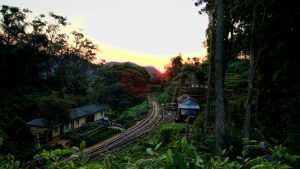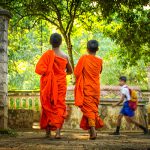Introduction
Also known as the “Pearl of the Indian Ocean”, Sri Lanka has been hiding in plain sight for decades and is now becoming the ideal destination for an enjoyable holiday. Uncrowded beaches, well-preserved ruins from centuries ago, flavorful cuisine, and diverse wildlife – everything needed for a memorable vacation!
Located just south of India, Sri Lanka is a small, pearl-shaped country in the Indian Ocean. As you walk along the streets of the country, you’ll hear locals greeting you with a chorus of “Ayubowan”, which is a warm and welcoming way of saying hello in Sri Lanka. The warm locals of the nation appreciate tourism very much, making Sri Lanka a truly memorable visit.
The cultural diversity of Sri Lanka
Being a small island nation, the country has a comparatively diverse cultural landscape, particularly because of its century-old history. Four religions are prominently being practiced in the country – Sinhala being the vast majority, followed by Tamils, Muslims, and Christians. In addition to that, four different European powers colonized the island – Dutch, Portuguese, and British. These colonization influences along with the multi-cultural population as well as the diverse natural landscape have resulted in an amazing concoction and several unique cultural traditions prevailing in Sri Lanka.
Let us now discuss the cultural hotspots in Sri Lanka and the highlights of each.
Cultural Triangle of Sri Lanka
Sri Lanka is home to a cultural triangle, constituting three cities:
- Anuradhapura
- Polonnaruwa
- Dambulla
Anuradhapura being the Sinhalese capital and Polonnaruwa being the medieval capital, both cities are rich in well-preserved ruins. Sigiriya boasts an incredible rock fortress while Dambulla hosts an amazingly preserved cave monastery. National parks and elephant safaris in the vicinity of Dambulla and Habarana are also popular activities. If you have limited time for your cultural tour in Sri Lanka, these hotspots located in central Sri Lanka are highly recommended and well worth your time.
Tip: Keep in mind that throughout most of your cultural tour, it is advisable to wear conservative clothing that covers your shoulders and knees. Footwear may have to be removed before entering some sites so it might be useful to carry a pair of socks to avoid your feet from burning.
Must visit iconic cultural hotspots during your Sri Lanka trip
Anuradhapura
Anuradhapura is a historical paradise that is home to many monasteries, palaces, and monuments. Established as the first capital city of Sri Lanka in 377 BC, Anuradhapura was built around a sacred Bo Tree, which is still existing today! For about 900 years, the city was on the peak of political and religious activities, which is enough to imagine how much history and culture can be explored in Anuradhapura. From brick stupas to dagobas, ancient ponds and pools to magnificent Buddhist Temples, don’t miss out on including this ancient city on your cultural tour of Sri Lanka.
Polonnaruwa
What you’ll love about the famous ancient city of Polonnaruwa is that there is a great amount of architectural variety in the area. From temples to royal palace ruins, baths, brick walls, Buddha statues, and other Buddhist rock carvings are the different historical sites you will explore. And the best part is that these are all within walking distance or you could rent a cycle to move around. You can also walk amongst the old buildings to get an actual feel of what it was like to live in medieval Sri Lanka. About 3-4 hours is sufficient to explore the history and culture in Polonnaruwa, and when you are out on your own, be it on foot, cycle, or private vehicle, you have the freedom to choose less popular spots to enjoy quiet time at temples by yourself.
Lion’s Rock – Sigiriya
What makes the Lion’s Rock in Sigiriya a popular hotspot is that the peak of the flat rock rises much higher than everything within its environment, making it recognizable from far and beyond, as well as offering an incredible view from the top. The lion gateway halfway up the rock is commendable preservation that is featured in several travel photographs.
Built in the late 400s by King Kasyapa of the Sinhalese Kingdom, this rock fortress is architectural excellence, particularly the water gardens and irrigation facilities that were thought about even so many centuries ago. Beautiful paintings and engraved frescoes are to be seen along the way up, as well as remnants of the fortress at the summit.
Marked as a UNESCO World Heritage Site, it takes about 3 hours to climb up and back down the Sigiriya Rock Fortress and is a very do-able activity for most. The best time to climb is either in the early morning before the sun gets too harsh, or late evening – when the sun is about a couple of hours from setting. Tickets can be bought at the entrance or online as well to save a few minutes of queuing. The site is open from 7 am – 7 pm, and the last time to enter the complex is 5 pm.
Pidurangala Rock
Culture enthusiasts who also love a bit of adventure will enjoy this climb as it involves a small hike as you get closer to the top. Some people choose to climb Pidurangala as a better alternative to Sigiriya because you get to experience the same views from the summit but you also have a stunning view of the bouldering Sigiriya rock in the distance.
About one and a half to two hours is sufficient for climbing this rock, depending on how fast you are and how much time you like to spend at the top. It is hot indeed, so remember to time yourself accordingly.
Dambulla Cave Temple
This site is over 2000 years old – cave temples on a hilltop, and is exceptionally well preserved. A collection of temples at the top of the rock, each beautified with Buddha statues and other gorgeous paintings. The site has been remodeled and repainted to ensure top-notch maintenance, but its origin remains intact.
Cave 1 is the most impressive indeed with a massive Buddha statue inside it. Cave 2 has beautiful murals painted everywhere inside, including the ceiling. It takes about an hour and a half to climb up, see the paintings and come back down. The monkeys along the pathway add a playful touch to the entire experience.
Mihintale
Sri Lankans believe Mihintale is where Buddhism began in Sri Lanka – the religious site where a Buddhist monk named Mahinda met King Devanampiya Tissa and introduced the religion to him. Located close to Anuradhapura, this temple is built on the top of a mountain and involves climbing many many steps. A gigantic Buddha statue is at the top, as well as some beautiful views that are especially colorful at sunset. The pathway is lit so you don’t have to worry about getting back down in the dark. But remember, because of its religious significance, Mihintale can be crowded on local holidays.
Kandy
Surrounded by forested hills and fenced by the Mahaveli River, Kandy was the capital city from the 15th to 19th century. Tourists flock to Kandy for its beautiful aesthetics enhanced by the man-made Kandy Lake, the popular Temple of the Sacred Tooth Relic – Sri Dalada Maligawa, and the serene greenery. The evening cultural dances that take place at clubs are also an enjoyable attraction for those exploring the Sri Lanka culture.
The Temple is one of the most esteemed of the Buddhist world, thereby attracting Buddhists from all over the world to visit at least once during their tour in Sri Lanka. Every year, during the months of July/August, a massive procession takes place to honor the Tooth Relic Shrine – known as the Esala Perahera. Exhibiting talents of music, dancing, stilt walking, fire drills, and attractive costumes, this is an event worth being a part of if you happen to be visiting during that time.
Colombo
Although Colombo is presently the trading hub of Sri Lanka, it is rich in history and culture. From exclusively designed buildings of the Dutch and British eras to Buddhist Temples and Museums, Colombo’s cultural attractions can be explored in a couple of days. Some of the places to visit include the Beria Lake, Seema Malaka Temple, Gangaramaya Vihara, Old Parliament Building, Kelaniya Raja Maha Viharaya, Colombo National Museum, and the Pettah Market.
Galle
The Galle Fort – a UNESCO World Heritage Site is a must-visit during your tour of the southern coast of Sri Lanka. Built-in the 16th century, this historic fortress is known for its well-preserved walls and Dutch colonial architecture. While you’re here, don’t forget to take a moment to admire the incredible architecture of the Galle Fort Clock Tower.
Another highlight of this area is the narrow streets and alleys of the fortified city with typical Dutch/British style buildings transformed into residences, hotels, boutiques, cafes, and restaurants, making it a highly touristic vicinity.
The Dutch Reformed Church from the 18th century is a simple, yet appealing attraction along with the cemetery outside which has well-preserved epitaphs to date. The Maritime Archeology Museum in Galle is another site worth visiting to observe the various antiquities recovered from 26 shipwrecks in the Indian Ocean.
Jaffna
After being restricted access during the three-decade-long civil war in Sri Lanka, Jaffna has recently opened for tourism and is developing at a rapid pace. Nagadeepa Temple, Nallur Temple, Delft Island, Jaffna Fort, and the gorgeous coastal beaches of Jaffna are some attractions worth visiting if you happen to tour the North of Sri Lanka. From Colombo, there are nighttime buses that depart at about 8.30 pm and reach Jaffna early in the morning, there are also several train options that you can take, the fastest being the newly launched 6-hour express train to Jaffna. Flights are also an option for faster traveling and restricted time availability as Jaffna has a functioning international airport.
Nuwara Eliya
While Kandy gives you a glimpse of Sri Lanka’s hill country, Nuwara Eliya takes you further inland, offering more striking views of tea plantations, mountains, valleys, waterfalls, and so much more. Being very much above sea level, the air is cooler here, which most visitors prefer for a cozy vacation. Nearby cultural excursions are linked to the Ramayana trail such as the Seeta Amman Temple, Sri Bhakta Hanuman Temple, Ravana Cave, and Ravana Falls. There are also some churches of the British era that are worth visiting along with other scenic and adventurous attractions such as Horton Plains National Park, Moon Plains, Lover’s Leap Waterfall, Adam’s Peak, and more.



